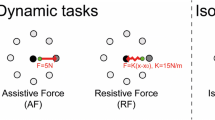Summary
The relationship between the speed of the fastest possible voluntary contractions and their amplitude was examined for several hand- and forearm muscles under isometric and isotonic conditions.
The consistent finding was the amplitude dependence of the speed of the fastest voluntary efforts: the larger the amplitude, the faster the contraction. The increase of the rate of rise of isometric tension or of the velocity of isotonic movements with rising amplitude was linear. The slope of this relationship was the same for three different hand- and forearm muscles examined.
The duration of the contractions measured from onset to peak was approximately constant for all amplitudes. The duration of the EMG-burst recorded from the contracting muscle was similar as the time from onset to peak of the contraction.
These results show that the skeleto-motor speed control system operates by adjusting the velocity of a contraction to its amplitude in such a way that the contraction time remains approximately constant. It is suggested that this type of speed control is a necessary requirement for the synchrony of synergistic muscle contractions.
Similar content being viewed by others
References
Annett, J., Golby, C.W., Kay, H.: The measurement of elements in an assembly task — the information output of the human operator. Quart. J. exp. Psychol. 10, 1–11 (1958)
Büdingen, H.J., Freund, H.-J.: The relationship between the rate of rise of isometric tension and motor unit recruitment in a human forearm muscle. Pflügers Arch. 362, 61–67 (1976)
Buller, A.J., Lewis, D.M.: The rate of tension development in isometric tetanic contractions of mammalian fast and slow skeletal muscle. J. Physiol. (Lond.) 176, 337–354 (165)
Cooper, S., Eccles, J.C.: The isometric responses of mammalian muscles. J. Physiol. (Lond.) 69, 377–385 (1930)
Conrad, B., Brooks, V.B.: Effects of dentate cooling on rapid alternating arm movements. J. Neurophysiol. 37, 792–804 (1974)
Flowers, K.A.: Ballistic and corrective movements on an aiming task: intention tremor and Parkinsonian movement disorders compared. Neurology (Minneap.) 25, 413–421 (1975)
Flowers, K.A.: Visual ‘closed-loop’ and ‘open-loop’ characteristics of voluntary movement in patients with Parkinsonism and intention tremor. Brain 99, 269–310 (1976)
Freund, H.-J., Büdingen, H.J., Dietz, V.: Activity of single motor units from human forearm muscles during voluntary isometric contractions. J. Neurophysiol. 38, 933–946 (1975)
Fuchs, A.F., Luschei, E.S.: Firing patterns of abducens neurons of alert monkeys in relationship to horizontal eye movement. J. Neurophysiol. 33, 382–392 (1970)
Johns, R.J., Draper, I.T.: The control of movement in normal subjects. Bull. Johns Hopk. Hosp. 115, 447–464 (1964)
Katz, D.: Gestaltpsychologie, pp. 124–129. Basel: Schwabe 1948
Kornhuber, H.H.: Motor functions of cerebellum and basal ganglia: the cerebellocortical saccadic (ballistic) clock, the cerebellonuclear hold regulator, and the basal ganglia ramp (voluntary speed smooth movement) generator. Kybernetik 8, 157–162 (1971)
Marsden, C.D., Meadows, J.C., Merton, P.A.: Isolated single motor units in human muscle and their rate of discharge during maximal voluntary effort. J. Physiol. (Lond.) 217, 12P (1971)
Merton, P.A.: Voluntary strength and fatigue. J. Physiol. (Lond.) 123, 553–564 (1954)
Robinson, O.A.: The mechanics of human saccadic eye movement. J. Physiol. (Lond.) 174, 245–264 (1964)
Robinson, O.A.: Oculomotor unit behaviour in the monkey. J. Neurophysiol. 33, 393–404 (1970)
Schiller, P.H.: The discharge characteristics of single units in the oculomotor and abducens nuclei of the unanesthetized monkey. Exp. Brain Res. 10, 347–362 (1970)
Searle, L.V., Taylor, F.V.: Studies of tracking behaviour. I. Rate and time characteristics of simple corrective movements. J. exp. Psychol. 38, 615–631 (1948)
Taylor, F.V., Birmingham, H.P.: Studies of tracking behaviour. II. The acceleration pattern of quick manual corrective responses. J. exp. Psychol. 38, 783–795 (1948)
Welford, A.T., Norris, A.H., Shock, N.W.: Speed and accuracy of movement and their changes with age. In: W.G. Koster (Ed.), Attention and Performance, II. Acta Psychol. (Amst.) 30, 3–15 (1969)
Author information
Authors and Affiliations
Additional information
This work was supported by the Deutsche Forschungsgemeinschaft, SFB 70
Rights and permissions
About this article
Cite this article
Freund, H.J., Büdingen, H.J. The relationship between speed and amplitude of the fastest voluntary contractions of human arm muscles. Exp Brain Res 31, 1–12 (1978). https://doi.org/10.1007/BF00235800
Received:
Issue Date:
DOI: https://doi.org/10.1007/BF00235800



